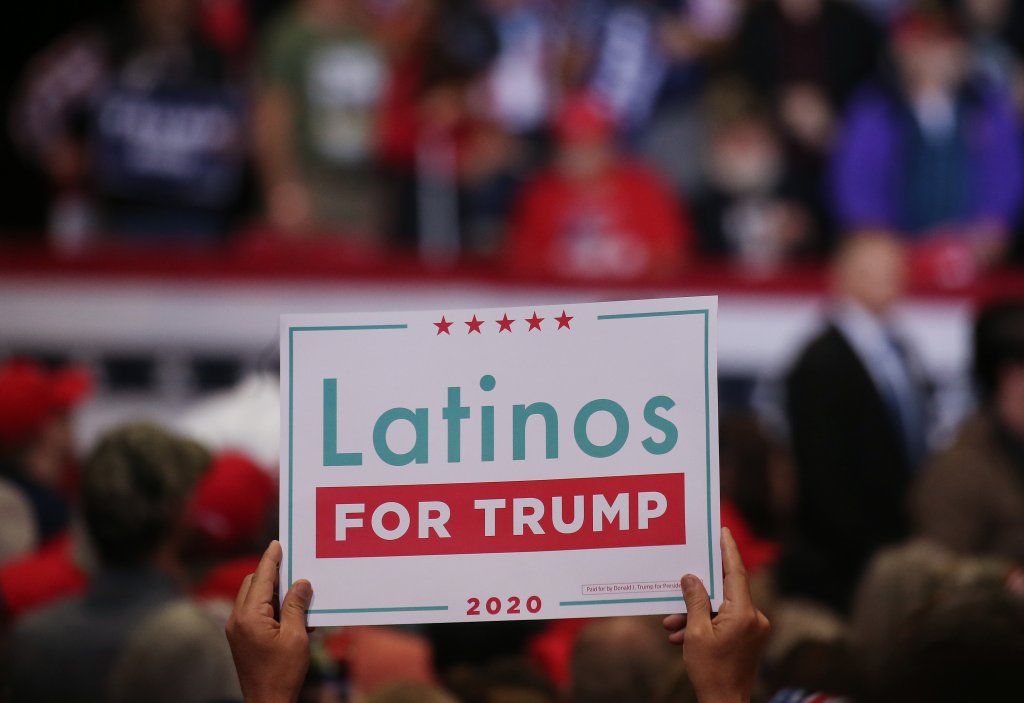
A supporter of President Donald Trump holds a ‘Latinos for Trump’ sign at a campaign rally. (Photo by Mario Tama/Getty Images)
Florida’s conversion from a swing state to a red one became obvious after the 2022 election, when Ron DeSantis won in previously blue counties like Miami-Dade, Hillsborough, Duval, and Osceola on his way to a 19-point blowout over Democrat Charlie Crist in the race for governor.
So, it’s no surprise that Donald Trump won some of those same blue counties over Democrat Kamala Harris in Florida’s presidential election on Tuesday night, reaffirming the dominance of the GOP in this former battleground state.
All told, Trump flipped six counties that Joe Biden won in 2020: Miami-Dade, Hillsborough, Pinellas, Duval, Seminole, and Osceola — which supported Biden by 14 percentage points that year, and Hillary Clinton by 25 points in 2016.

“I think that’s a surprising trend, because if you look at the voter registration numbers in Osceola, Democrats still have a 20,000-voter lead in registration in that county, and yet Trump won,” said Aubrey Jewett, a professor of political science at the University of Central Florida.
There are exactly 20,257 more registered Democrats than registered Republicans in Osceola, according to the local supervisor of elections website. There are 86,373 registered independents in the county.
Hispanics and Trump
The Hispanic vote’s move towards Trump nationally was evident in in Osceola. Trump received 45% of the Hispanic vote in the election, according to a CNN exit poll. Osceola County is 56% Hispanic, according to U.S. Census data, with the largest subset being of Puerto Rican descent.
“We can attribute Osceola voting for Trump for several reasons,” said Jewett. “One, broadly, we have seen Hispanics across the country and certainly in Florida moved towards Trump in the last eight years, so he’s getting a higher percentage of Hispanics, particularly Hispanic males without a college degree.”
Although Cuban Americans in Florida have been leaning Republicans for years, Jewett said, it’s notable to see the Puerto Rican community move to the right. “Puerto Ricans were traditionally Democratic leaning,” he said. “Apparently, Trump has been able to make inroads with that community as well.”
Tampa Bay area political strategist Barry Edwards believes one of the reasons why Republicans are increasing their margins in Florida is the “massive erosion amongst Hispanics towards the Republicans, because of a rejection of what they perceive as ‘woke’ liberal policies.”
“They’re just too far to the left for a typical, Catholic, Puerto-Rican family,” he added.
Other notable swings of Florida counties that backed Biden in 2020 but flipped to Trump this week include Miami-Dade, which went for Trump by 11 points – 55%-44% — on Tuesday. In 2020, Biden won there by 7 percentage points, 53%-46%.
Blue counties
And while Trump did incrementally better percentagewise in all 67 Florida counties, some of the bluest counties still voted strongly for Harris, such as in Leon County. There, the voting public went for the Democratic nominee by a decisive 22 points, 60%-38%. That’s down percentagewise from 2020, when they voted for Biden 64%-36%.
In Gadsden County, Harris won 65%-34%, a 21-point margin of victory. Yet it was down from Biden’s performance in 2020, when he won by 26 points, 68%-32%.
Trump did not win his home county of Palm Beach this week, but it was close: Harris took 49.76% of the vote, Trump 49.02% — a difference of just 5,511 votes out of 747,676 cast. By comparison, Biden defeated Trump by 13 percentage points in Palm Beach in 2020, 56%-43%.
No other county shows how much Florida politics has changed over the past four years than Pinellas. In 2020, Pinellas was heralded nationally as a quintessential swing county, as this New York Times story depicts. And it certainly lived up to its reputation for picking the winner that year, when Biden won by 0.22 percentage points over Trump.
And this year? Trump won easily, by more than 5 percentage points.
In other traditional red counties like Lee, Polk, and Brevard, Trump increased his win totals by 5 percentage points.
In addition to Hispanics moving toward the GOP, Edwards said, other reasons why the Florida GOP continues to dominate is that over the past four years voter registration in all 67 counties gained “massive net numbers of Republicans vs. Democrats”; also, that Republicans continue to have better turnout in elections, and that there remain some so-called “Dixiecrats” — registered Democrats who reliably vote for Republicans.

